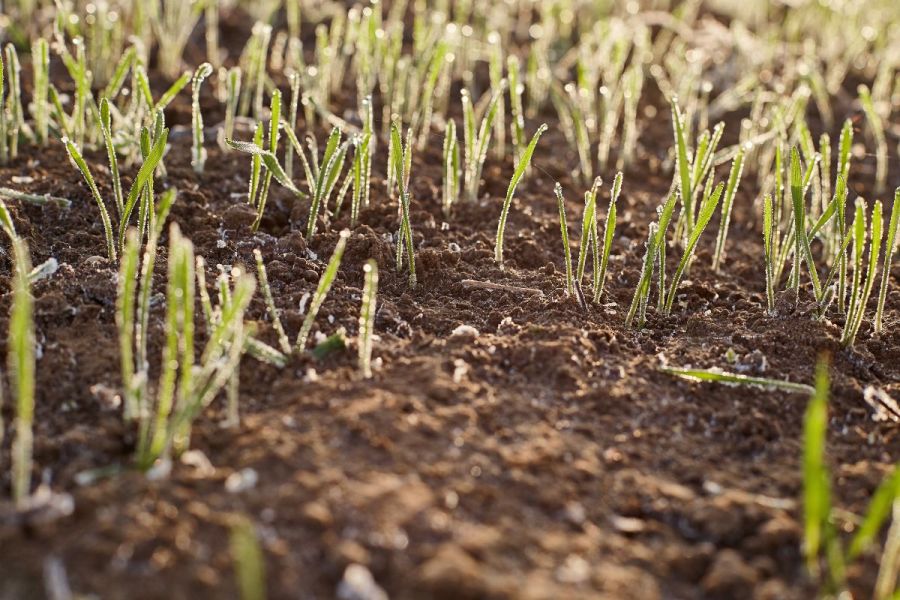With the use of agricultural inputs under increased scrutiny, standard approaches to crop nutrition are being supplemented by helping the plant to, literally, help itself. CPM finds out how biological technologies are achieving this.
Research shows that nitrogen use efficiency and phosphate use efficiency are intrinsically linked, a small change in one can give a big change in the other.
By Lucy de la Pasture
The 2022 season has sat growers back on their heels and forced an examination of how fertilisers are being used on the farm. With high prices and in the effort to reduce any environmental impacts, particularly where phosphorus is finding its way into watercourses, the focus has turned to increasing the efficient use of nutrients by plants.
And it’s an area where there’s a significant opportunity to work both with the soil and with plants, by using biological approaches to improve the way nutrients are both taken up and assimilated, believes John Haywood, director of Unium Bioscience.

Historically, the conversation around plant nutrition has been all about meeting the crop’s needs and not depleting soil supplies, that approach has to change to include how much of the applied nutrient is taken up as well as how well it’s assimilated and utilised by the plant, suggests John Haywood.
“Nutrient uptake by plants is a complex area and is influenced by a number of factors, including soil type, pH, abundance of natural minerals in the soil which may interfere with uptake, and the form in which nutrients are applied, to name just a few,” he says.
But some of these limitations can be overcome by working with the plant and enhancing its own ability to scavenge and take up nutrients. It’s a process that can be influenced right from the very start of the crop’s life – the seed, believes John.
Integral to that approach is the role of endophytes – part of the diverse natural communities which exist in the soil microbiome and form associations with plants.
“Endophytes are microbial symbionts which reside in the plant for the majority (if not all) of their life without causing harm. The use of these natural symbionts is widely thought to offer an opportunity to help boost agricultural productivity while reducing the environmental impacts of agriculture,” says John.
While all sorts of endophytes can occur in association with crop plants and colonise their tissues, more specific strains which bring added benefits, such as nitrogen fixation and phosphorus sequestration and solubilisation, have been found after extensive research by Dr Sharon Doty at Washington University in the United States. Only recently have these been commercialised and available initially as a seed treatment, Tiros, and subsequentially as a foliar applied spray, Tarbis.
John sees endophytes as having a crucial role in helping growers to achieve better nutrient use efficiency. “Using endophyte treatments, such as Tiros on the seed or Tarbis at the three-leaf stage, inoculates the plant with two strains of bacterial endophyte – one to solubilise and sequester phosphorus and one to fix atmospheric nitrogen.”
That provides a platform for increased use efficiency of both nutrients, he believes, but it something that can be further enhanced by a programmed approach.
Traditionally nitrogen and phosphorus are treated very much as separate entities when considering the needs of plants but the link between them, and other nutrients, is a strong one. “Research shows that nitrogen use efficiency and phosphate use efficiency are intrinsically linked, a small change in one can give a big change in the other.
“Historically, the conversation around plant nutrition has been all about meeting the crop’s needs and not depleting soil supplies, hence the emphasis on maintaining soils at Index 2 for phosphorus and potassium. That approach has to change to include how much of the applied nutrient is taken up as well as how well it’s assimilated and utilised by the plant,” suggests John.
But phosphate-use efficiency is an area which John believes has been largely ignored, though personally it’s an area he’s been working in for more than 20 years. “It’s been generally accepted as okay that a crop only utilises only a small percentage of the phosphate applied. Because of this inefficiency, traditional forms of phosphate are over-applied in an effort to meet plant needs, with implications for the environment.”
To build on the foundations of the endophyte association, which acts as a back up engine to the plant throughout its life, the specialist company has developed a new approach to phosphorus supply this season, he explains.
“Our new soil or foliar applied phosphorus fertiliser, Luxor, is based on two forms of available phosphorus in a humic/fulvic acid complex to maximise availability and reduce adsorption in the soil,” he says.
And when it comes to phosphorus, its availability is absolutely key. “When considering phosphate, it exists in three pools in the soil. Only the inorganic phosphate that has dissolved in soil water, which is the smallest pool of phosphate in the soil, is readily available to the plant,” he explains.
To help plants grab hold of that available phosphorus in the soil, there’s another tweak growers can use to their advantage – phosphite with PGA (pidolic acid). It’s something John has studies for years and he has settled on a specific form of phosphite as the best form to offer to crop plants.
“The final piece of the jigsaw is to use calcium phosphite (in Calfite Extra or Acalsa), which is the most effective and safest form of phosphite. Applying phosphite tricks the plant into thinking it’s phosphorus deficient so it takes up more. It also encourages root growth length and volume for better scavenging, as well as increasing exudation to support soil biology,” he explains.
Another benefit of this alternative approach to supplying nutrition is a more benign effect on the soil’s biology, believes John. “High levels of phosphate can have a negative impact on mycorrhizae. In contrast, phosphite doesn’t have this negative effect, despite only being one oxygen molecule different. So calcium phosphite is a great way of mining the phosphorus reserves without harming the soil biology.”
What John isn’t suggesting is to throw the baby out with the bathwater. Soil testing and usual checks and balances should remain. He recommends growers analyse a representative field every year so they can see the impacts of any changes made and can adjust their approach accordingly.
“However, a six-year rotational GPS block trial of winter wheat, winter barley and oilseed rape, showed there are clear opportunities to enhance phosphate use efficiency. Our approach outperformed 100kg/ha of TSP or DAP, which is very important especially when it’s reached the prices it has. This finding also applies to other crops, such as potatoes and maize,” adds John.

Nitrogen can boost uptake of phosphorus by plants, but with the high cost of both and the potentially negative environmental impacts, we’re looking at new growing techniques, says Niall Atkinson.
The proof of the pudding is always in the eating and, according to independent farming consultant Niall Atkinson – who also works closely with Agrovista – biological approaches are seeing rapid uptake on farm and are now routinely added to some crops, with a positive impact on nutrient use efficiency.
He says optimising phosphorus use efficiency in the establishment phase is key to healthy plants. “Phosphate is like an energy drink to a plant and helps to get the roots established well. Not only is it expensive but it also gets locked up quickly, meaning it’s not readily available to the plant – especially in high calcium soils.
“Standard approaches to phosphorus application can be inefficient, and it’s generally believed that the use efficiency of phosphorus is low – between 10-25%. Nitrogen can boost its uptake in the plant, but with the high cost of both and the potentially negative environmental impacts, we’re looking at new growing techniques.
“This starts with the soil and the roots. The more we can do to get a good root system on the crop, the more potential that crop has to use the nutrients in the soil,” says Niall. He advocates using Phosta, which is a soil-applied phosphate liberator, and a liquid gypsum that helps to improve the soil structure – which is good for improving the root mass of plants. He also suggests applying a molasses-based product to help feed soil microbes.
Products that help seedling establishment are seeing increased use in farming. Biological seed treatments Voltek and Tiros are well proven and have performed well in trials, says Niall.
Voltek, also from Unium, is a nutrient biostimulant complex which maximises seed germination, plant establishment and triggers root development. It’s often combined with the endophyte seed treatment Tiros, which helps to fix atmospheric nitrogen and solubilise the supply of phosphorus, he explains.
“Once the plant is established, we will look to use Calfite Extra, a foliar phosphite treatment, and Luxor – a blend of phosphorus forms and other nutrients, humic and fulvic acid, along with PGA (pidolic acid) to enhance photosynthesis and carbon fixation,” says Niall.
“Topping up with phosphate and phosphite biostimulants, as well as humic acids, helps the plant roots receive water and nutrients,” he believes.
“The more you can do to get a good root system going, the better. For those farms which are drilling early, crops can be susceptible to aphids, and for those that delay drilling due to blackgrass concerns, establishment can be compromised, and this is where biological seed treatments come into their own.
“There is a huge potential saving to be made from not applying bagged fertiliser. With prices at circa £1000/t when they are usually £300/tonne, alternatives are a must and you can’t just ignore phosphate, which the plant requires for a strong root system,” says Niall.
“We’re also coming under more legislative pressure. If we can use a seed treatment to improve phosphorus and nitrogen take up in the plant and then apply a foliar treatment rather than soil, that’s a big win for the environment.
“We can then cut back on bagged nitrogen which has a huge effect on soil health and any farms’ carbon footprint,” he adds.
Reducing inputs with an inexpensive solution

According to Andrew Cromie, farmers are increasingly considering a phosphorus or potassium (or both) holiday but recognising the link between phosphorus and its impact on nitrogen use efficiency, Unium has created a very efficient programme at a fraction of the cost of an inefficient granular programme.
Andrew Cromie has recently started working for Unium Bioscience and has been using biostimulants on his own farm to help his crops take up nutrients. He farms arable, grass and cattle on 485ha of land in Cambridgeshire.
“We aren’t ‘regenerative’, but like everyone else, we’re looking to reduce inputs where we can,” he says. “We’re ordering nitrogen more carefully and have reduced the volume by 5-10%. We also have used a mixture of farmyard manure, PKUP or P-Grow, some TSP and DAP.
“We push our crops hard, but we want to farm for tomorrow as well as today. We’ve found we can reduce conventional inputs with relatively inexpensive biological products.”
Andrew says Tiros is genuinely cost-effective. “It costs £66/tonne and if we spend £140/ha on a TSP equivalent, spread that to twice the area and add Tiros, that gives us a £95/ha reduction in cost. We apply the endophyte treatment to all our first milling wheat seed to increase nitrogen use efficiency, and we also add Luxor, for phosphorus uptake.
“With the low cost, limited environmental impact and positive results we’ve seen, we’d be mad not to put it on everything,” believes Andrew.
“Farmers are increasingly considering a phosphorus or potassium (or both) holiday, but we should recognise the link between phosphorus and its impact on nitrogen use efficiency. Hence after years of research, Unium has created a very efficient programme at a fraction of the cost of an inefficient granular programme.
“It supplies phosphorus very efficiently and also encourages increased solubilisation and uptake from the soil, a real win-win all round,” he adds.
Bioscience in practice
As the chemistry toolbox continues to shrink, a mesmerising array of new bio-solutions are coming to market, offering a range of benefits and complementary additions. Evaluating just how effective they are, and where they’re best placed can be tricky.
In 2021 CPM teamed up with Unium BioScience to open the science behind these innovations. In this second series of articles we explore how bioscience can be utilised in the field, building on our understanding of the physiological processes and trials data. Above all, these articles give the grower an inside view on some of the exciting opportunities biosolutions offer in the field.
Nutrient use efficiency is a hot topic at the moment, with prices rocketing and products becoming hard to find. At Unium we are combining many years of experience with tried and tested technologies to help farmers find affordable solutions that will maximise their yields and profits.
Click here to learn more and sign up to the Unium Bioscience free technical group, where growers can explore and discuss high-quality technical information.
This article was taken from the latest issue of CPM. For more articles like this, subscribe here.




